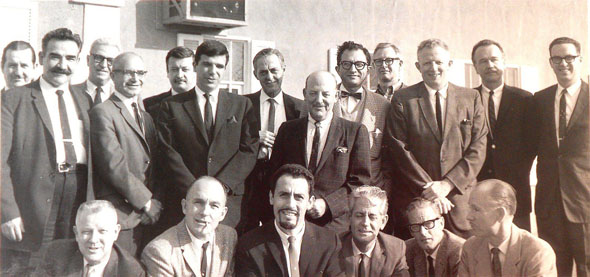
The last days of Warner Bros. Cartoons – (back row, l to r): Bob McKimson, Bill Tytla, Harry Love, Tom O’Loughlin, Dave De Patie, Treg Brown, Friz Freleng, Lee Halpern, Bob Matz, Lew Irwin, Hawley Pratt, Bill Orcutt; (front row, l to r): Gerry Chiniquy, Art Leonardi, O. B. Barkley, John Dunn and Virgil Ross
JANUARY 1963
These columns usually didn’t acknowledge when a person left the studio – or any dramatic changes of company status – but it was undeniable at this point. David DePatie notes here that this is “our final holiday season together as a division of this company” – and the columnist acknowledges the November 30th (1962) resignation of Friz Freleng after “29 years” (Actually, not counting his one year away at MGM, Friz was with the studio for over 30 years!)
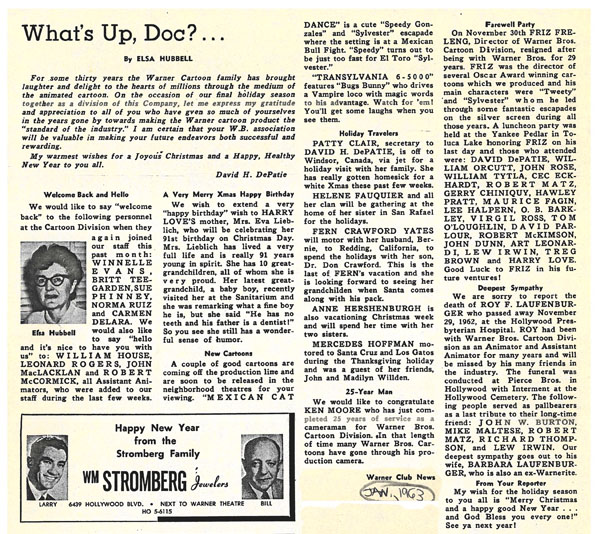
FEBRUARY 1963
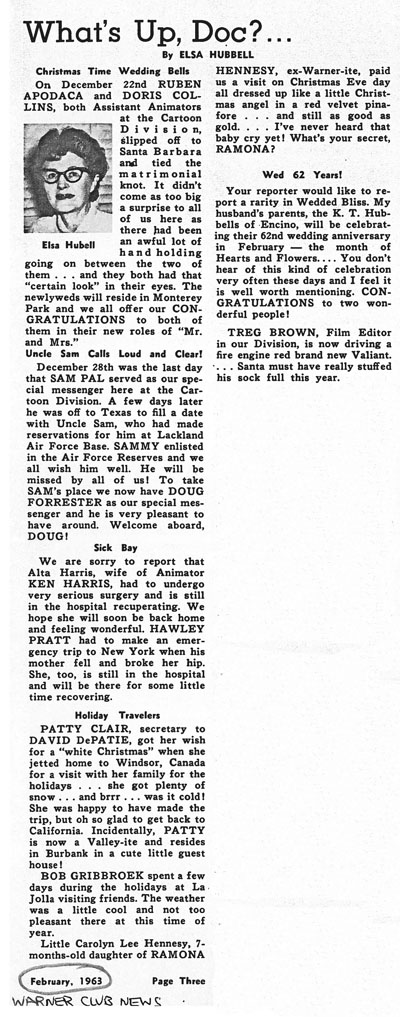
MARCH 1963
This month marked the passing of Robert McKimson’s wife and Art Leonardi’s father… of Chuck Jones’ Now Hear This being nominated for an Oscar… but more fascinating are these recently uncovered memos from David DePatie to his father Edward discussing details of continuing the cartoon studio as an independent, privately owned company, DePatie-Freleng Enterprises. Kinda like the company Leon Schlesinger Productions was – before Warners bought ’em.
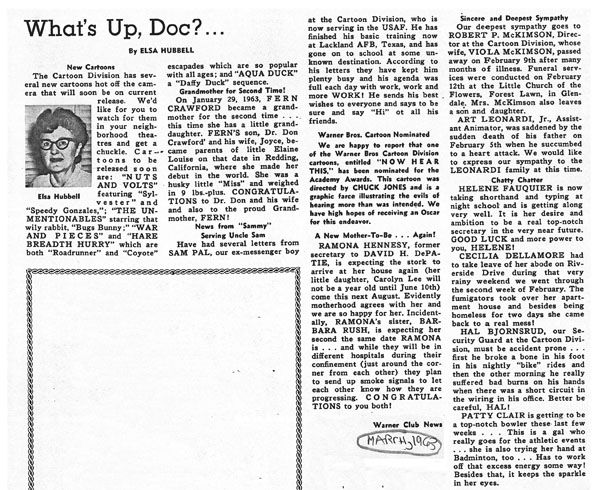
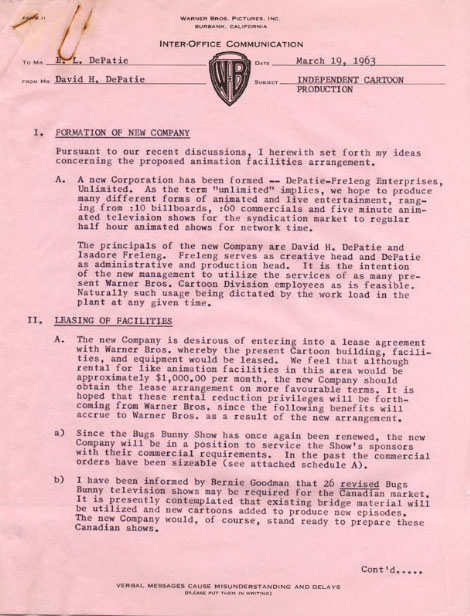
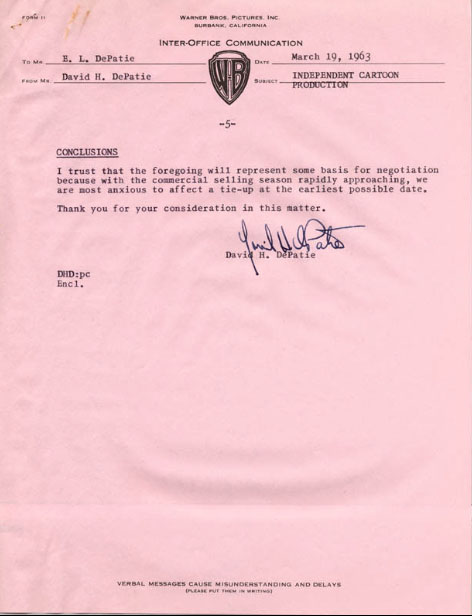
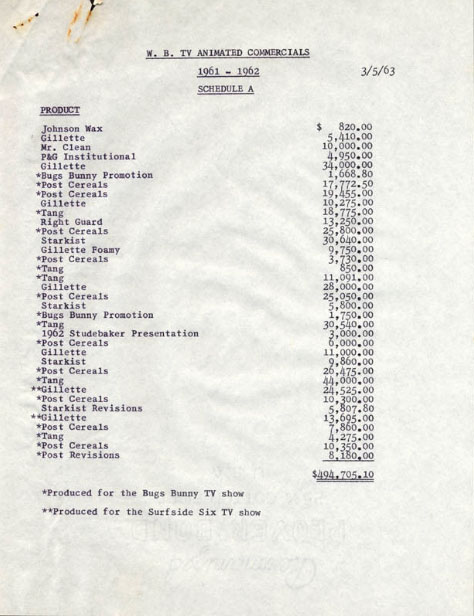
APRIL 1963
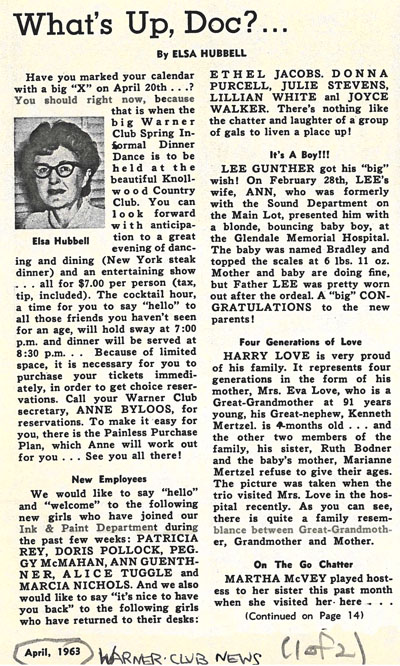

MAY 1963
This is the final employee column emanating from the Warner Bros. Cartoon Division for the Warner Club News. Nothing special. Rather dull… the staff is finishing up post production of the 1963-1964 season of cartoon shorts… completing ink-and paint work on The Incredible Mr. Limpet (curiously never mentioned in these columns). In a few months DePatie Freleng would move in, but for now…
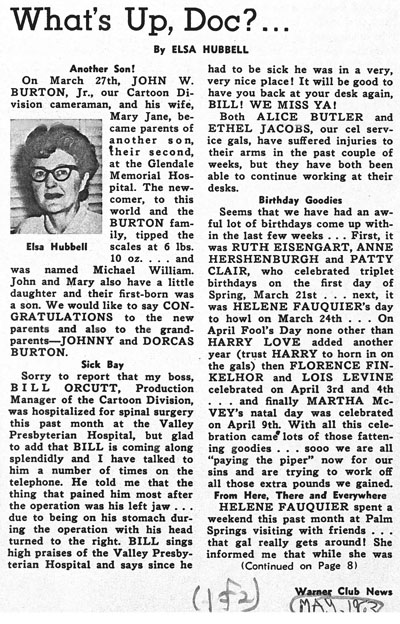
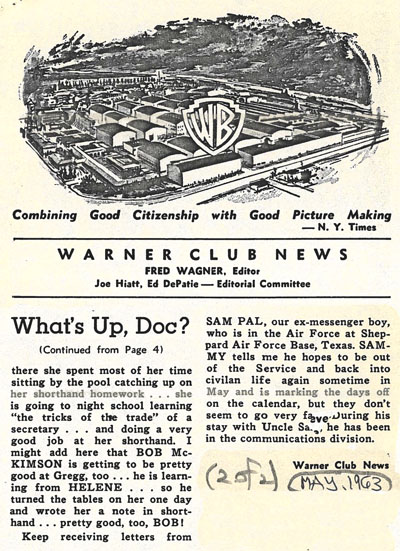
JUNE 1963
In June 1963, Warner Bros. released a Robert Preston, Tony Randall comedy called Island Of Love. In it, Tony Randall plays a ghost writer who, after being liquored up by con-man Robert Preston, will write any old junk… including (as indicated in the clip below) a “Bugs Bunny” cartoon.
It’s almost as if the studio was saying that the worst thing a writer could do, the lowest wrung on the creative totem pole, was to pen a cartoon… a Bugs Bunny cartoon. What a sad way to commemorate the closing of the greatest short cartoon studio of all time.
Released JANUARY 1964
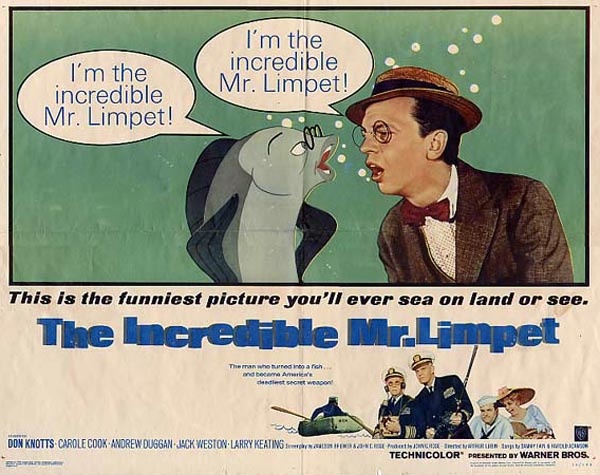
“That’s All, Folks!”
(Thanks, Ned Comstock)


 Jerry Beck is a writer, animation producer, college professor and author of more than 15 books on animation history. He is a former studio exec with Nickelodeon Movies and Disney, and has written for The Hollywood Reporter and Variety. He has curated cartoons for DVD and Blu-ray compilations and has lent his expertise to dozens of bonus documentaries and audio commentaries on such. Beck is currently on the faculty of CalArts in Valencia, UCLA in Westwood and Woodbury University in Burbank – teaching animation history. More about Jerry Beck [
Jerry Beck is a writer, animation producer, college professor and author of more than 15 books on animation history. He is a former studio exec with Nickelodeon Movies and Disney, and has written for The Hollywood Reporter and Variety. He has curated cartoons for DVD and Blu-ray compilations and has lent his expertise to dozens of bonus documentaries and audio commentaries on such. Beck is currently on the faculty of CalArts in Valencia, UCLA in Westwood and Woodbury University in Burbank – teaching animation history. More about Jerry Beck [



































Jerry, it’s been a fascinating trip through time in the Warner cartoon studio – even if I gleaned a more profound knowledge of the gals in Ink and Paint than anything else. Like Gene Deitch’s HOW TO SUCCEED IN ANIMATION did for Terrytoons, we’ve walked through the halls of the building and experienced the day to day work life of some great talented people.
Thanks!
Very much AGREED!
I wonder why there was no mention of Mr. Limpet in the newsletter. The animators would have certainly considered it a prestige project, even if the rest of the studio didn’t. Perhaps many of them didn’t find it as fun as the cartoons?
At any rate, there should probably be a post about the making of Mr. Limpet. There should be some interesting stories there.
The writer was a corporate secretary in an office. She didn’t hang out with animators. She seems to have been hung up on bridge club-type gossip–babies, birthdays, etc.
Much like the studio, the newsletters went downhill from what they were in the 1940s editions.
Jerry should be thanked for making these public to give everyone a bit of a window on what was happening at the studio.
Given that Friz left in Nov. ’62, and a written proposal was presented to Warners the following March, I wonder when he and DePatie conceived the idea for their studio. It would appear Friz’s sojourn at Hanna-Barbera after leaving Warners was only intended to be temporary. (Variety didn’t mention the creation of DePatie-Freleng until its issue of May 31st).
No indication that a certain pink feline is waiting around the corner…
It’s been great getting to know the people behind the cartoons and their daily lives and milestones. This Warner Club News has been a real treat to follow each week.
Thanks, Jerry!
Yes, I would love to see this Monday series touch some on Mr. Limpet, then follow the history of DePatie-Freleng’s output.
As always, thanks Jerry!
“No indication that a certain pink feline is waiting around the corner…”
…unless you consider the color of the paper that the memo detailing the proposal for the new studio is printed on…
“No indication that a certain pink feline is waiting around the corner…”
…unless you consider the color of the paper that the memo for the proposal of the new studio is printed on…
On “Island of Love” slamming the Bugs Bunny cartoons, maybe Tony Randall was referring to the ones made in that final few years..!
My though exactly!
“A couple of good cartoons are coming off the production line” […] “MEXICAN CAT DANCE”
[stifles laughter]
I thought Friz was at MGM for 2 years…
Actually he was at MGM for about 18 months. From late 1937 through April 1939. More than a year, less that two.
“THANKS, MAN, FOR ALL THE (WARNER CLUB) NEWSLETTERS.”
They were enjoyed, so enjoyed.
Inquiring minds want to know: Did Harry Love ever find love?
Al, from what I have read, when Harry was at Hanna-Barbera, he and Joe Barbera used to go out for lunch and have their eye on the waitresses. It doesn’t, however, appear he married.
The real interesting thing the newsletter reveals is Harry Love changed his name from Lieblich. Lo and behold, the 1930 census for the Bronx lists shows a Harold Lieblich, age 19, occupation movie cartoonist. (His father sold cigars).
His mom passed away in Los Angeles on Nov. 29, 1963.
I’m never sure how many cartoons Friz Freleng directed for MGM. I may have been misinformed somehow that Friz actually directed “THE BOOK WORM”, a cartoon attributed to Hugh Harman, but I gather that someone will correct me. All I’d heard about regarding Freleng’s tenure at MGM was that he loathed doing the CAPTAIN AND THE KIDS series. Despite that, I liked Freleng’s entries in the series, and it was nice to see ’em in heavy rotation on Cartoon Network for “LATE NIGHT BLACK AND WHITE”. I only wish a series like that lasted to see all Warner Brotehrs black and white entries included in that heavy rotation.
So were the 26 revised Bugs Bunny TV shows done, and if so, made available for us USA viewers?
I just read the same with interest. I would say the answer to your question would be “No”. I remember those new “Bugs Bunny Show” episodes airing on the CBC that were vastly different than what I would see from the USA on ABC, at the time. To my recollection there were many of the 1960’s cartoons included in the “revised” shows including “Transylvania 6-5000”, “Mad As A Mars Hare” and “Message to Gracias” to name but a few. I would guess that we saw this “revised” line-up by 1965 and those airings continued well into the early 1970’s. “The Bugs Bunny Show” on the CBC would air once a week and usually on Saturday afternoons, if my memory serves, at least by the 1970’s. I think Mr. DePatie knew full well that the end titles of each episode would have to be revised to include mention of the titles of the three cartoons that were run with their copyright dates listed. I think this was certainly the case because little eagle-eyed kid here knew the titles and dates of the cartoons even though the original titles had been removed in the airings. It has to be taken into consideration that by 1964 or 1965 the “funny-animal” cartoon genre was being threatened by the superhero craze. “Jonny Quest” and “Superman” and other shows with cartoon humanoids were becoming very popular, relegating “The Bugs Bunny Show” to second tier status airing on Sunday mornings at one point on ABC by the late 1960’s. I do know that ABC still ran “The Bugs Bunny Show” (in colour) at twelve noon every Saturday to at least 1967 or so, as I got to see it on a colour TV set at the grand opening of the executive offices of the Philips Electronics Industries in Leaside, Canada (where my Dad worked as a tool and dye maker). I remember seeing “My Bunny Lies Over the Sea” on a brand new Philips colour TV set there from a broadcast emanating from Buffalo, NY. Canadian tv broadcasters began colour broadcasting September 1, 1966.
Thanks for digging these newsletters up, Jerry. It’s all very interesting to see how DePatie-Freleng evolved and the “Island of Love” clip certainly showed how little respect that great division received. You find the most amazing treasures.
Strange that in none of the most recent of these newsletters was there any mention of animator Manuel Perez. I know for a fact that Perez started with WB some years before the studio’s official closure, receiving credit on all the cartoon shorts he worked on, and continued his tenure when the studio transitioned into DePatie-Freleng Enterprises. Was there any unchecked bias towards Mexican-American artists at the studio that fellow WB alums have acknowledged in recent years?
All I can submit is that Manny Perez was seen to be Friz’s “whipping boy”, for some reason or another, so I was told by Virgil Ross. But Manny Perez was not credited on Warner Bros. Cartoons after the 1955 releases, which means he probably left prior to the 1953 layoff. Manny did return to work for Friz Freleng at DePatie-Freleng and animated on many short cartoons until 1971. I met Manny in April 1975 when he was doing storyboard direction and writing for the film “Metamorphoses”, a Japanese animated film being made in California, supervised by Willie Ito and Jerry Eisenberg. I asked him about his work for Freleng. He said, “Yes, I worked for him for a long time. You know…after a while…I got to HATE that little guy…”.
There was mention of Ken Harris’ wife Alta being very ill in hospital. I’m pretty sure she died around this time.